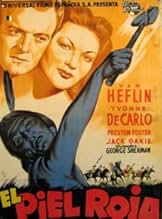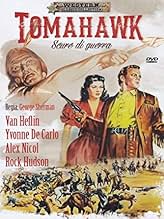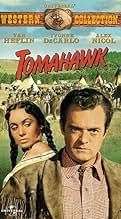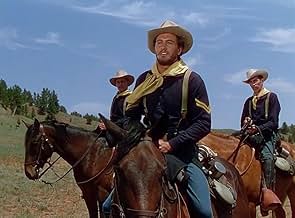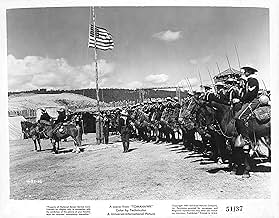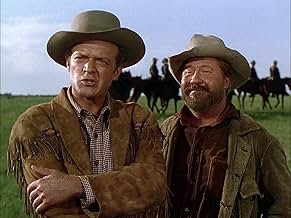Tomahawk
- 1951
- Tous publics
- 1h 22m
IMDb RATING
6.4/10
1.2K
YOUR RATING
In 1866 Wyoming, a frontier scout tries to prevent a war between the Sioux and the U.S. after the Army builds a road and a fort on territory previously ceded to the Sioux by treaty.In 1866 Wyoming, a frontier scout tries to prevent a war between the Sioux and the U.S. after the Army builds a road and a fort on territory previously ceded to the Sioux by treaty.In 1866 Wyoming, a frontier scout tries to prevent a war between the Sioux and the U.S. after the Army builds a road and a fort on territory previously ceded to the Sioux by treaty.
- Director
- Writers
- Stars
Russ Conway
- Maj. Horton
- (as Russell Conway)
Chief American Horse
- Indian
- (uncredited)
Sheila Darcy
- Woman
- (uncredited)
Abner George
- Man
- (uncredited)
James A. Hermstad
- Man
- (uncredited)
- Director
- Writers
- All cast & crew
- Production, box office & more at IMDbPro
Featured reviews
It's 1866 in the Wyoming territory, and the US government is trying to forge a treaty with the Sioux for access through the region to gold-rich Montana. The natives reluctantly agree thanks to the intervention of white friend-to-the-Indian Jim Bridger (Van Heflin). The army sets up a new fort to protect the trail, and Bridger agrees to work as a scout for them, but he has a secret ulterior motive. Things at the fort get more complicated when traveling entertainer Julie Madden (Yvonne De Carlo) is forced to take shelter there.
This was a rare sympathetic portrayal of Native Americans for the time, depicted as a noble people continuously mistreated by the US government yet hopelessly outmatched and with nothing but the end to look forward to. There's also a compelling plot involving revenge for a long-ago injustice. Unfortunately, not a lot really happens in the movie, and what does happen is very predictable. De Carlo, once again looking ravishing, has little to do, and only serves a single purpose in the plot. Jack Oakie is also wasted as a fur-trapper companion to Heflin
This was a rare sympathetic portrayal of Native Americans for the time, depicted as a noble people continuously mistreated by the US government yet hopelessly outmatched and with nothing but the end to look forward to. There's also a compelling plot involving revenge for a long-ago injustice. Unfortunately, not a lot really happens in the movie, and what does happen is very predictable. De Carlo, once again looking ravishing, has little to do, and only serves a single purpose in the plot. Jack Oakie is also wasted as a fur-trapper companion to Heflin
Just found a video of Tomahawk at a yard sale. The filming itself was beautiful in glorious Technicolor! If you are a Western fan you will like this one, so give it a watch if you have the opportunity. Van Heflin played Jim Bridger the famous mountain man and scout. Mr. Heflin was a wonderful actor, but I think I would have chosen someone else to play the legendary Bridger. He just didn't seem rough and tough enough for the part. Maybe he did such a good job in Shane that I type cast him myself. Still, he did a very good acting job in this one. Good old Jack Oakie was the side kick and added the light touch of humor. His acting experience was always welcome in any movie. Another great character actor, Tom Tully, ran a traveling medicine type wagon show with Yvonne De Carlo as his assistant. I don't remember seeing her lovelier. Preston Foster as the always reliable man in charge as the commander of the fort. Alex Nicol played his part well as the bad guy (who kills Indians from hate). An early bit part for Rock Hudson as Hanna. By the look on his sleeve he was a corporal. Watch fast or you will miss him. Ann Doran was Preston Foster's wife Mrs. Col. Carrington, always a reliable actress (remember her as James Dean's mother in Rebel Without A Cause?) The very lovely Susan Cabot played an Indian girl who travels with Jim Bridger since her family was killed by the Chivington gang (Susan was murdered in 1986 by her son who suffered from dwarfism). Red Cloud was played very ably by John War Eagle. He was a veteran of many movies and TV work, mostly westerns such as Winchester 73, Annie Get Your Gun with Betty Hutton, Sgt. Preston, Annie Oakley, Buffalo Bill Jr, Roy Rogers show, etc. Capt. Fetterman was played by Arthur Space a long time character actor along with Russell Conway as Major Horton another great character actor. It is just a good old fashioned Western with plenty of action. Don't worry about historical facts or get caught up in the old treatment of Native Americans debate. We are all aware that the Indians got a raw deal in many a treaty and that white, black and red people were murdered without reason. The movie is meant to entertain. Let it do its job and just enjoy the movie for what it is. Well worth watching!
A famous trapper by the name of "Jim Bridger" (Van Heflin) signs on as scout under the command of "Colonel Carrington" (Preston Foster) to assist him at a small fort in Sioux Country. While he has every intention of assisting the colonel, he also has an ulterior motive and that is establish if the killer of his Cheyenne wife and son is a cavalry officer named "Lt. Rob Dancey" (Alex Nicol) stationed at the fort. At any rate, rather than give away the entire story I will just say that this film turns out to be a pretty solid western, all things considered. While the acting isn't great and some of the battle tactics seem rather strange, the scenery was nice and the open terrain was definitely used to great advantage in the action scenes. Good performances were turned in by the aforementioned Van Heflin along with Susan Cabot as the pretty Cheyenne maiden named "Monahseetah". Likewise, Yvonne De Carlo did well as "Julie Madden" who happens to arrive at the fort en route to Virginia City. But in my opinion the best performance was by Alex Nicol who seemed perfectly cast for the part. In short, those who enjoy a good western probably won't be disappointed with this movie.
When the US breaks a treaty with the Sioux in order to access gold on Indian land, the specter of war looms.
Wow!—this may be the biggest big sky movie of all time. Those blue and white expanses almost swallow up the viewer in their awesome majesty. This is a really underrated Western that I expect got lost in Universal's crowd of Technicolor oaters of the time. But it's got a superior script that dares to put Indian rights on the same level as the settlers', plus outstanding photography and first-rate performances from Heflin and Foster. Then too, DeCarlo really looks good in Technicolor. Also, I detected only one exterior set—the Heflin- DeCarlo conflab in the forest. Pretty good for lower-budget Universal.
I'm especially glad they used real Indians in close-ups instead of the usual Hollywood types made-up to look evil. That way, the 'original Americans' are humanized, and we become more aware of the real costs involved in Winning the West. But notice, those good intentions don't extend to all the Sioux. Hollywood reverts to form by dressing up a comely white girl (Cabot) as the Indian maiden, instead of using a real Indian girl. At the same time, Monahseetah has few lines so a professional actress wasn't really needed. So draw your own conclusions.
The action is pretty much standard, except for the massed attack on the equipment wagons. There, the script makes clear that it's the white man's technology that triumphs and not his superior fighting skills. However, I wondered why the Sioux didn't attack in steady waves instead of in intervals that give the soldiers time to re-load. And catch that final scene in the fort. That's certainly no cliché.
I don't know how much of the story is based on fact, but however much, it at least makes you think. Anyway, this is a grandly scenic, gutsy Western, definitely underrated, and deserving of more than just a few scattered showings.
Wow!—this may be the biggest big sky movie of all time. Those blue and white expanses almost swallow up the viewer in their awesome majesty. This is a really underrated Western that I expect got lost in Universal's crowd of Technicolor oaters of the time. But it's got a superior script that dares to put Indian rights on the same level as the settlers', plus outstanding photography and first-rate performances from Heflin and Foster. Then too, DeCarlo really looks good in Technicolor. Also, I detected only one exterior set—the Heflin- DeCarlo conflab in the forest. Pretty good for lower-budget Universal.
I'm especially glad they used real Indians in close-ups instead of the usual Hollywood types made-up to look evil. That way, the 'original Americans' are humanized, and we become more aware of the real costs involved in Winning the West. But notice, those good intentions don't extend to all the Sioux. Hollywood reverts to form by dressing up a comely white girl (Cabot) as the Indian maiden, instead of using a real Indian girl. At the same time, Monahseetah has few lines so a professional actress wasn't really needed. So draw your own conclusions.
The action is pretty much standard, except for the massed attack on the equipment wagons. There, the script makes clear that it's the white man's technology that triumphs and not his superior fighting skills. However, I wondered why the Sioux didn't attack in steady waves instead of in intervals that give the soldiers time to re-load. And catch that final scene in the fort. That's certainly no cliché.
I don't know how much of the story is based on fact, but however much, it at least makes you think. Anyway, this is a grandly scenic, gutsy Western, definitely underrated, and deserving of more than just a few scattered showings.
Universal's western is an entertaining cavalry-Indian affair that details the frontier adventure from the point of view of famed scout Jim Bridger. The film recounts the usual treaty-breaking by whites that despoils the Indians' hunting grounds, the conflicts of which lead to war between the Sioux tribes and the troopers. Two major battles, the Fetterman engagement and the Wagon-Box Fight are touched on as well as tensions caused by an Indian-hating lieutenant. The lush, beautiful country and wild buffalo herds lend authenticity to the story and keep the film moving at a good clip. Van Heflin is sincere as the scout who knows Indians and understands their grievances. Yvonne De Carlo is striking as Bridger's love interest although an Indian girl complicates matters a bit. The cast is good, especially John War Eagle as Red Cloud. Hans Salter contributes a nice traditional western music score.
Did you know
- TriviaA bearded Rock Hudson is barely recognizable, except perhaps by his voice, until he gets a relative close-up an hour and six minutes into the film. Up to that point, he is further away from the camera.
- GoofsWhen Dancy is shot and killed by an arrow, padding can clearly be seen beneath his shirt.
- Quotes
Dan Castello: I have to keep moving. Got iron in my blood. If I sit still, I rust.
- Alternate versionsAccording to Wikipedia, Tomahawk was originally released in the UK under the title "Battle of Powder River". The reference for this is given as Monthly Film Bulletin, 18 (204), London, January 1, 1951, p. 217 and google searches return images of movie posters in that name. The title is erroneous, however, as the real Battle of Powder River took place just over the border, in Montana, in 1876, ten years after the events depicted in Tomahawk.
- How long is Tomahawk?Powered by Alexa
Details
Box office
- Budget
- $750,000 (estimated)
- Runtime
- 1h 22m(82 min)
- Aspect ratio
- 1.33 : 1
Contribute to this page
Suggest an edit or add missing content

